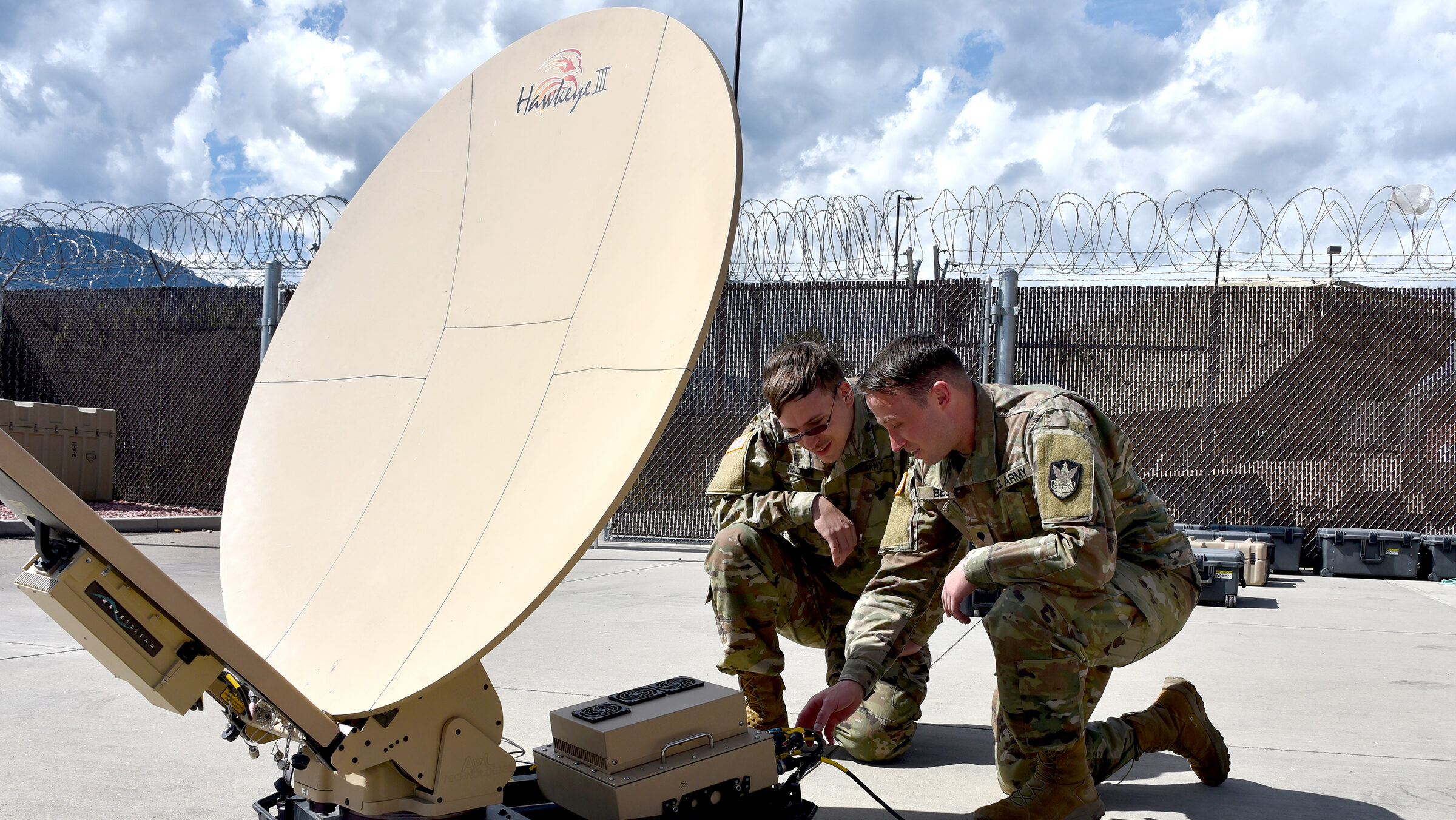
On August 13, Breaking Defense published an opinion piece from Charles Galbreath and Jennifer Reeves of the Mitchell Institute, which called for Pentagon leaders to kill plans from the US Army to expand its space capabilities. The op-ed has become the talk of the Army space community. Below, two key Army officers offer their formal rebuttal.
A recent Breaking Defense op-ed from Charles Galbreath and Jennifer Reeves of the Mitchell Institute, titled “The Army wants its own ‘Space Force.’ They shouldn’t be allowed to have it,” misses key points about the Army’s space capabilities, and requires additional context and objective analysis.
Following the creation of the Space Force, the Army, alongside each military service, retained military and civilian space personnel and capabilities to address service-unique requirements. More than that, the Department of Defense (DoD), the Joint Staff, the US Space Force, and the US Space Command are actively encouraging all military services to increase their space forces and develop space capabilities. This is consistent with guidance outlined in numerous DoD-level policies and forums, as well as the annual Defense Planning Guidance.
Hence, the core notion that the Army does not currently have its own space forces is an inaccurate claim from the outset, and the argument that the rest of the military is naturally opposed to the Army having a role in space does not hold water.
In 2019, the Space Force was established to “organize, train, and equip military and civilian personnel to maintain freedom of operation in, from, and to space,” and “address current and emerging threats as we compete, deter, and, if necessary, win in space.” In simple terms, the Space Force was created to achieve space superiority, which is unique from any other military service. The Army has since transferred its satellite operations and missile warning functions, along with over 600 military and civilian personnel, to our nation’s newest service. Along with these interservice transfers, the Space Force received the requisite resources to perform the aforementioned functions.
But the Space Force can’t do it all, and individual military service investments in space forces and capabilities have distinct purposes based on service-specific requirements. Army space forces and capabilities are designed to integrate with and protect ground maneuver forces from hostile threats emanating from space, facilitate deep sensing, as well as enable movement and maneuver. Because military services have different purposes for the use and employment of space forces and space-related capabilities, there is little duplication among the services. For instance, the Army is pursuing the development of space interdiction capabilities, also referred to as space control capabilities, that are small, highly maneuverable, and can be integrated into ground maneuver units at scale. The unique requirements of each military service necessitate equally tailored space forces and capabilities. For Army space forces, this includes recruiting second-term or second-accession space professionals with relevant ground maneuver experience.
None of this is new. In the years following the Space Force’s establishment, the Army and the Space Force created an Interservice Planning Council to assist with transferring the “preponderance of space missions, capabilities, and associated military and civilian personnel from across the military services into the Space Force.” The recent op-ed seemingly conflates “preponderance” with “all” space missions, capabilities, and forces, as well as overlooks the caveat in the long-term vision “as appropriate and authorized.” In January 2023, detailed analysis of this deliberate, transparent process was officially conveyed in a Space Force-authored Report to Congressional Committees titled “Transferring Space Assets and Personnel from Army to Space Force.” This report highlights the history and plans to transfer appropriate Army space-related forces, authorities, and activities to the Space Force as directed by Space Policy Directive-4 (SPD-4). It also includes the justification for space-related forces, authorities, and activities that the Army will retain.
The op-ed’s conclusions are seemingly devoid of the discourse in joint forums like the Joint Requirements Oversight Council, the Deputies Management Action Group, the Space Acquisition Council, and the Space Integration Forum, a key point that cannot be ignored. Given all that, the claims in the misinformed op-ed that the Army “wastes precious resources,” “undermines jointness,” and “drives organizational fissures” are unfounded.
The op-ed goes further stating “the most egregious move is the development and stand-up of the multidomain task forces (MDTFs),” and question the organizing, training, and equipping roles and responsibilities between the Army, a miliary service, and the Combatant Command (COCOM). That position lacks a nuanced understanding of the Global Force Management process and how services present forces to COCOMs. In stark contrast to this sentiment, the Department of Defense and COCOMs are actually requesting the Army to accelerate and increase its MDTFs.
All the military services have space forces and capabilities, but what differentiates service-unique forces and capabilities is their mission and higher purpose. The Army is not going to “usurp” the Space Force, nor does it want to. For the Joint Force to be effective, we must overcome domain parochialism. For example, the op-ed suggests the Air Force does not have ships but the service clearly does maintain a modest fleet of watercraft. The point is that the purpose of an Air Force ship is a service-unique requirement that cannot be readily supported by another military service like the Navy.
Shortly after Breaking Defense published the opinion piece, Gen. Stephen Whiting, the current SPACECOM Commanding General, made a public statement disagreeing with their positions. Whiting emphasized that “space expertise does not have to be exclusive to the Space Force” and joint space forces and capabilities are vital to military operations in the space domain. Whiting had firsthand knowledge of the Army-Space Force interservice transfer process in his previous role overseeing Space Operations Command, now rebranded as Space Forces – Space (S4S). Consistent with interservice planning efforts, he reinforced that Army space forces and capabilities do not encroach on Space Force roles and responsibilities and “as a combatant commander, [he] want[s] capabilities.”
It’s no surprise, based on his position and experience, that Whiting would publicly defend the Army’s space focus. SPACECOM consists of joint space forces and capabilities from each military service. With firsthand experience, SPACECOM is highly effective because it consists of joint space forces from each service. An Army military occupational specialty for space for its enlisted personnel is a positive step that allows the Army to more effectively integrate into SPACECOM, as well as the regional COCOMs.
Space Force has the preponderance of space missions, capabilities, and personnel — and this will not change. The multiyear interservice transfer process was conducted in a thorough, meticulous, and transparent manner. Results from the Army and Space Force process were published in a detailed Report to Congressional Committees as directed by SPD-4.
Upon conclusion of that meaningful work, Army space professionals began work on an updated Army Space Vision. This document, endorsed by the Secretary of the Army, directed the Army to focus on integrating friendly space capabilities and interdicting adversary use of space capabilities for hostile purposes. The Army Space Vision builds upon the Vice Chairman of the Joint Chiefs of Staff-endorsed Army-Space Force interservice transfer agreement and Congressional report. It is also the reason the Army is contemplating a new military occupational specialty for Soldiers currently performing space interdiction missions.
No military service is going to out Space Force the Space Force, not even the Army. But the Army will continue to invest in space professionals and capabilities, because fighting and winning on a 21st-century battlefield demands it.
Col. Pete Atkinson is the Space Division Chief with the Headquarters, Department of the Army.
Maj. Gen. Jake Kwon is the Director of Strategic Operations with the Headquarters, Department of the Army.

